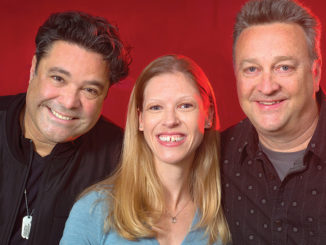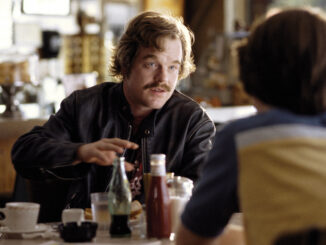
by Norman B. Schwartz
A wild track is a sound effect (or an additional line of dialogue) recorded on location without the camera rolling. During post-production, the audio recording is added off-screen, or synchronized with the film.
Shortly after its theatrical release, having barely made back its cost, the film was pulled from distribution, and quickly forgotten. In the decades that followed, it never quite acquired the noble status of a cult classic, nor was it ridiculed as one of the Golden Turkeys — the worst pictures ever made. It simply disappeared from view. What did not disappear, however, is my memory of it. For a brief moment in time, a very small group of decent, as well as some despicable people — all talented — had joined together to create an exceptional soundtrack.
It had all begun simply enough back in the 1970s, with my first vinous interview with the director and his film editor. Immediately upon engaging me as ADR editor, they handed me several cardboard boxes of wild magnetic recordings. But they didn’t tell me how to synchronize these dialogues with the faces and body movements of actors and extras who had improvised their actions, MOS, in alleys and streets far from the plywood back lots of Old Hollywood. To make the job even more difficult, these wild tracks had been done at some later point, in another studio. Without synchronous sound, there was no written or visual record of what anyone had said, and as I was not a lip reader but only a dialogue editor, I could only guess which tracks in my several boxes fit which actor, or extra.
The director knew that this was no easy task, and as is so often the case with sadists of infinite power and less than saintly character, he assured me that when it came to getting the desired result by spending other people’s money — in this instance, the studio’s — he was generous to a fault. “Time and money are no object!” he told me. “Do whatever it takes to get this right! No! Get it perfect!”
Not only had he taped all the spoken dialogue and crowd reactions — wild — for the first two opening scenes of the film, but he had recorded every possible ambient sound effect that might be heard in the rest of the story: the noise of city streets and alleys, passing cars, birds in trees, dogs barking and doors opening and closing. These were all sounds readily available in any standard sound library, but the editors assigned to the film were admonished not to use them on pain of something worse than death. Our house of sound was to be constructed, brick by brick, entirely from original material gathered “wild” on location.
Why the director had chosen not to record these voices (or the dance) live, or with something resembling a reference track to indicate where the sync was, none of us knew nor dared ask.
As I needed someone to make a transcript of what was actually being improvised in all the dialogue tracks, I hired a tall Irish-American of great beauty and short temper who had been my typist on another film, and who was willing to learn the ADR trade. Marian and I reported to a cramped suite of cutting rooms where a dozen other sound editors, soon to be known as the MOS Unit, were already housed. The first sounds I heard upon climbing the stairs of the building were those of tapping: tap, tap, tapping. One editor, a guy named Mickey — then invisible in a cutting room directly across the hall from ours — had been assigned the momentous, possibly impossible task of synching up the wild tracks of a blind man dancing with a cane.
In the story, a group of men, old high school buddies, hide in order to surprise the hero, who is returning from Vietnam to his hometown. As a camera operator perched above the action on a swinging Chapman boom had filmed these actions without sound in long shot, their improvised lines of dialogue (to say nothing of the blind man’s tapping) were hardly visible on the six-inch screen of my Moviola.
Why the director had chosen not to record these voices (or the dance) live, or with something resembling a reference track to indicate where the sync was, none of us knew nor dared ask. The painstaking synchronization, matching lips to words and stitching together each move of foot and stick, step by step, tap after tap after tap, went on incessantly for days.
Eventually, Marian, then new to the game, turned to me and said, “Tell me please, when the hell is this all going to stop? The tapping is driving me bananas.” As the days of synchronization work wore on, she became more and more convinced that we were all the unwitting victims of an abhorrent joke, the sort that the Marquis de Sade might have played had he been given a film to direct. I tried to explain that our colleague across the hall was only trying to accomplish what we had all been ordered to do: “Get it right. No! Get it perfect!”
Marian would have none of it. “No one has ever been asked to do this before,” she said. “I mean, trying to sync up a whole reel of dialogue and sound effects without a damn guide track to go by.” I told her that as far as I knew, we were the first.
The director knew that this was no easy task, and as is so often the case with sadists of infinite power and less than saintly character, he assured me that “Time and money are no object! Do whatever it takes to get this right! No! Get it perfect!”
“He knows why, but he won’t tell,” she exclaimed, in her Boston accent (the word “He” taking on biblical resonance). “He thinks it can’t be done, and once he sees and hears for sure, he’s going to fire all your asses and hire another crew just so he can make them suffer, too! Wait and see. The man is evil.”
She was not alone in this opinion. In time, Mickey, our neighbor across the hall — his nose pressed against the Moviola, magnifying glass in hand, eyes bloodshot and bleary from days of staring at feet and canes — came to share her view.
I knew the day when all the noises up and down the hall stopped, as they did that late-spring morning forty-some years ago, that I, too, would be obliged to gather together my tracks, however imperfectly synchronized, and preview them in the cold light thrown by a projector onto a gigantic screen. A secret session was scheduled in the studio. No one other than the dozen editors and assistants in the MOS Unit and a lone, sworn-to-secrecy re-recording mixer had been invited.
Boxes and boxes, reels and reels of sound effects and atmosphere tracks, along with the wild tracks, were loaded on machines in the back room, behind the control panel of the dubbing stage. The screening began. The familiar, comforting numbers of the Academy leader flashed on the screen, then the blast of a pop at the number 3. The first frame of the opening sequence in the alley hit at exactly 12:00 feet on the counter.
The room filled with sound: dialogues, Mickey’s tap-tapping, street noises, passing cars, a dog barking sullenly in the distance. The alleyway and its surroundings instantly came to life. Way off in the distance, an invisible jackhammer, cut so cleverly that at times its rat-tat-tat syncopated with the blind man’s tapping, could be heard. (This was the inspiration of a man I was yet to meet.) Halfway into the reel — at 564:00 feet, to be precise — the second MOS sequence, TIH (The Irish Homecoming), began.
“No one has ever been asked to do this before, I mean, trying to sync up a whole reel of dialogue and sound effects without a damn guide track to go by.” – Marian
The Vietnam vet returns home to find the mean streets draped with banners, children waving flags, young women cheering and blowing whistles, old women banging pots and crying beside their husbands, off-duty cops and firemen out of uniform — all this shot MOS on film, but recorded wild later on. When the final frame of film reached 986:00, the yellow leader and the blast of a tail pop signaled the end of the reel. When the lights stuttered on again, there was another noise in the room, a sound effect I had never heard before: a huge roar of approval, something not quite human, the blast of an elephant, the roar at the winning field goal in the Super Bowl.
“F*ckin’ perfecto!” someone behind me shouted, coming around and grabbing me in a bear hug. A barrage of expletives and blasphemies from the other editors followed; my colleagues shook each other’s hands, and high-fived their shared sense of accomplishment.
And then someone pointed to the front of the room. There, seated so close to the screen that his eyes appeared pressed to its reflective surface, Mickey stared up the vast, virgin, empty space, devoid now of sound and image. “I missed one tap as the car went by.”
Marian — the only woman in the crew — had not participated in the victory cries. Standing far from Mickey, beside the sole mixer at the console, and at some distance from the rest of us, she began to laugh. It was very infectious Irish laughter. Soon, the others below her joined in and the room was filled with its sound.
“You didn’t think we could do it, did you?” I asked, looking up at her from below the console.
“No. I will admit it. I did not. I certainly…did not.” She gathered up the dubbing charts, and headed to the door of the stage. Then she stopped, and in the voice of an ancient Celtic woman who has seen many of her sons go off to sea, some never to return, she turned to those of us remaining in the room:
“What about him? What is he going to think? What is the Evil One going to say?”





